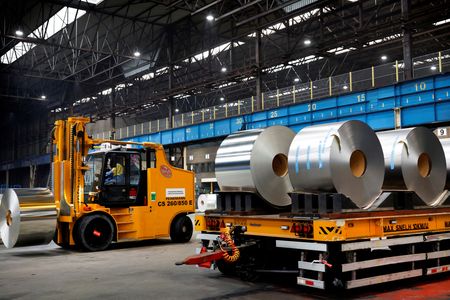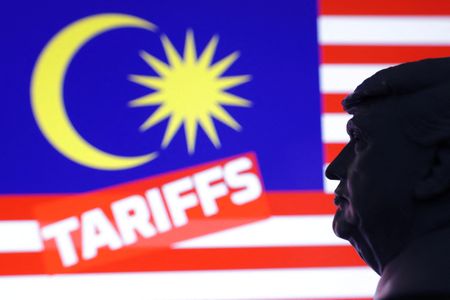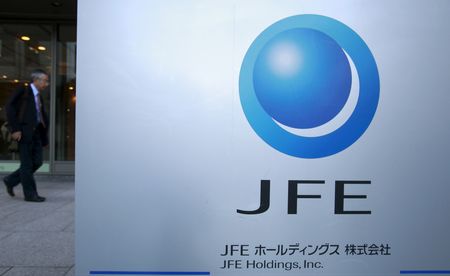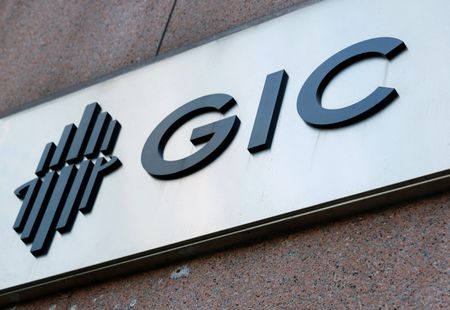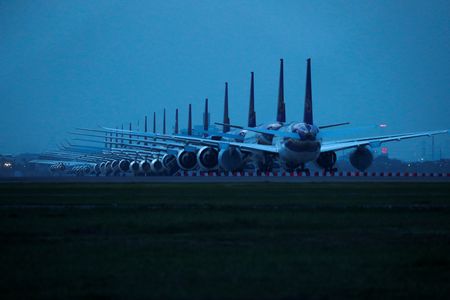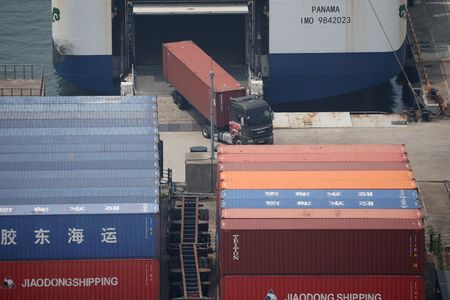By Eric Onstad
LONDON (Reuters) -Prices of industrial metals in the U.S. extended gains on Tuesday, reflecting the impact of U.S. President Donald Trump’s 25% tariffs on steel and aluminium as industry will struggle to source enough domestic material.
While the stated goal of the new tariffs is to aid struggling U.S. metal producers, it will take time to reopen closed plants and build new ones to compensate for large amounts of imports.
In the meantime, traders are marking up U.S. metals prices to reflect the price automakers and other industries will have to pay for foreign metal when the measures take effect on March 12.
The biggest impact will be on aluminium, used in transport, construction and packaging, with net imports accounting for around 82% of U.S. requirements, according to Morgan Stanley.
The U.S. aluminium premium over the global benchmark on the London Metal Exchange has shot up by a quarter since Friday to 35 cents per pound and has surged by 60% since Trump was elected.
“Aluminium capacities would have to be massively expanded in a short period of time to replace even a portion of the imports with domestic production,” said analyst Volkmar Baur at Commerzbank.
The United Steelworkers, a union representing U.S. and Canadian workers, said it welcomes efforts “to contain the global overcapacity that has for too long enabled bad actors like China to flood the global market,” but encouraged Trump to work with Canada.
“We must distinguish between trusted trade partners, like Canada, and those who are seeking to undercut our industries as they work to dominate the global market,” said David McCall, the USW’s CEO. The union has opposed efforts by Japan’s Nippon Steel to buy Pittsburgh-based U.S. Steel.
The American Primary Aluminium Association praised Trump for the tariffs.
“Today is a great day for the U.S. aluminium industry,” said Mark Duffy, president of the association.
But U.S. aluminium smelters produced only 670,000 metric tons of the metal last year, down from 3.7 million in 2000, while U.S. demand was 4.3 million tons, U.S. Geological Survey data showed.
About 470,000 tons of U.S. production has been curtailed, and could in theory restart, said Amy Gower at Morgan Stanley.
“But this would take at least 6-12 months in our view, depending on how much preparatory work has been done.”
Building new smelters would likely take even longer, she added.
That was underscored by the Washington-based Aluminum Association industry trade group, which said it appreciated Trump’s trade actions but would like to see more U.S. production.
“There is not enough smelting capacity in the United States to supply the growing aluminium industry with the input materials it needs,” said Charles Johnson, the association’s CEO.
New York-based PerenniAL, a privately held distributor of aluminium slab, wire rod, billet and other products used to make wheels, window frames and other products, said it planned to pass along any price increases to its customers.
“I don’t think anyone in the U.S. is more in favour of increasing domestic aluminium production than me, but it has to be done thoughtfully over several years,” said Brian Hesse, PerenniAL’s CEO. “You can’t cut your nose off to spite your face.”
STEEL, COPPER
The U.S. imports about a quarter of its steel, and domestic prices for U.S. hot rolled coil steel, a semi-processed product, have jumped by nearly 40% since last Thursday.
“Supply growth would not offset these volumes in most products, resulting in materially higher U.S. prices, if implemented,” said analyst Andrew Jones at UBS.
“The larger impact could be the negative impact on growth from an escalating trade war.”
In Canada, aluminium producers said they were ready to compete but warned the pricing ramifications could harm U.S. consumers, as a similar tariff did in Trump’s first term.
“Remembering how disruptive a 10% tariff was for the U.S. (aluminium) industry, I can only begin to imagine how destructive a 25% tariff will be for the U.S. economy,” said Jean Simard, CEO of the Aluminum Association of Canada.
Wider fears about slower economic growth and metals demand due to a possible trade war were reflected in a broad retreat in global industrial metals prices on Tuesday.
While Trump did not impose tariffs on copper on Monday, he did threaten duties on the metal last week.
Expectations that copper would be next propelled the premium of U.S. futures traded on Comex over the global benchmark on the London Metal Exchange to a record peak on Monday.
It pulled back slightly on Tuesday to $725 a ton from $930 at the close on Monday, but it is still roughly double its level at the end of January.
(Additional reporting by Tony Munroe in Singapore, Divya Rajagopal in Toronto, Ernest Scheyder in Houston, Melanie Burton in Melbourne, Hyunjoo Jin in Seoul, Amy Lv in Beijing and Francesco Guarascio in Hanoi; Editing by Veronica Brown, Christina Fincher, Ros Russell and David Gregorio)

